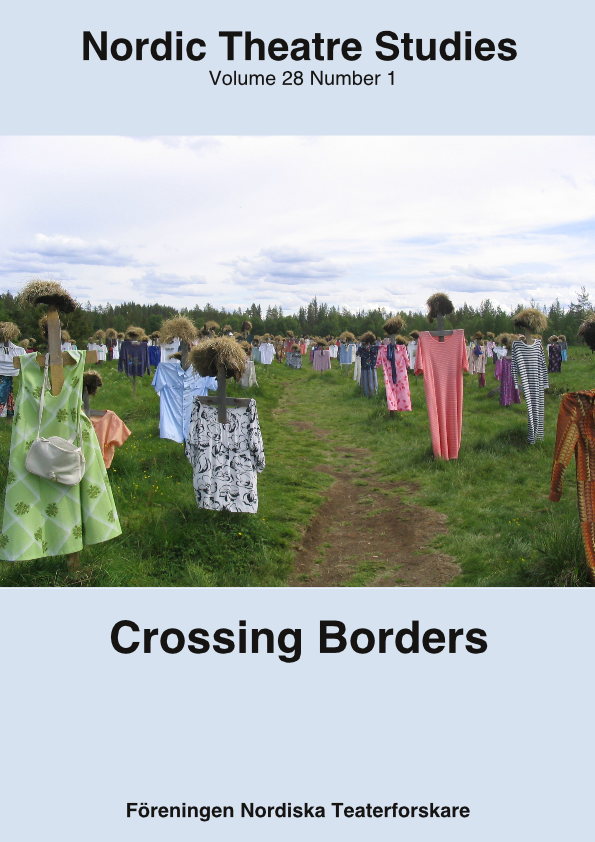S.O.S. - A Pacifist Intervention in Helsinki 1929. The Intercrossing of Modernism and Socialism
DOI:
https://doi.org/10.7146/nts.v28i1.23971Keywords:
workers’ theatre, political theatre, Hagar Olsson, S.O.S., pacifism, Koiton NäyttämöAbstract
The article examines the co-operation between a (Swedish-speaking) modernist author with a (Finnish-speaking) workers’ theatre in 1920s Finland. It shows how modernist aesthetics and the socialist movement met in the practices of the workers’ theatres and what dangers lay in this combination. I am especially interested in the moments when the radical intelligentsia - artists, writers, and theatre directors - joined forces with the workers’ theatres in order to create political theatre. Political turmoil was about to occur when Hagar Olsson’s play S.O.S. premiered in Helsinki in March 1929. The venue was the Koitto Theatre (in Finnish ”Koiton Näyttämö”), a semi-professional workers’ theatre run by a socialist temperance association, already known for its performances of German expressionist plays. In my paper, I ask what goals lay behind the co-operation between Olsson and Koitto – and what came out of it?
References
Christopher B. Balme, The Theatrical Public Sphere, Cambridge University Press, Cambridge 2014.
R. N. Coudenhove-Kalergi: Paneuropa ABC, Paneuropa-Verlag, Leipzig and Vienna 1931. J
örn Donner, ”Ett stycke historia” in Hagar Olsson, Tidig dramatik, Holger Schildts, Helsinki 1962.
Elsa Enäjärvi, ”Väinö Aaltonen näyttämökuvan luojana” in Tulenkantajat 12/1929.
Lena Fridell, Hagar Olsson och den nya teatern, Gothenburg University, Gothenburg 1973.
Pauliina Haasjoki, Häilyvyyden liittolaiset, University of Turku, Turku 2012.
Roger Holmström, Hagar Olsson och den öppna horisonten, Schildts, Helsinki 1993.
Pekka Kalevi Hämäläinen, In time of storm. Revolution, Civil War, and the Ethnolinguistic issue in Finland, State University of New York Press, Albany 1979.
Osmo Jussila et al., From Grand Duchy to Modern State. A Political History of Finland since 1809, Hurst, London 1999.
Åsmund Egge and Svend Rybner (eds.), Red Star in the North. Communism in the Nordic Countries, Orkana Akademisk, Stamsund 2015.
Pirkko Koski, Kansan teatteri (part I), Helsingin Teatterisäätiö, Helsinki 1986.
Ulla-Britt Lagerroth, Regi i möte med drama och samhälle, Rabén & Sjögren, Stockholm 1978.
Judith Meurer-Bongardt, Wo Atlantis am Horizont leuchtet, Åbo Akademi, Turku 2011.
Eric Olsoni, Från Strindberg till Anouilh, Söderströms, Helsingfors 1964.
Hagar Olsson, ”Finländsk robinsonad” in Quosego 3/1928.
Hagar Olsson, Ny generation, Holger Schiltds, Helsingfors 1925.
Hagar Olsson, ”En teaterupplevelse”, in Nya Argus 3/1928.
Hagar Olsson, ”Spelet har börjat” in Quosego 2/1928.
Hagar Olsson, S. O. S. (Save Our Souls), Holger Schildts, Helsinki 1928.
Hagar Olsson, På Kanaanexpressen, Holger Schildt, Stockholm and Helsinki 1929.
Hagar Olsson, ”Aktiivinen rauhanliike” in Tulenkantajat 21/1929.
Taisto-Bertil Orsmaa, Teatterimme käänne, Gaudeamus, Helsinki 1976.
Raija-Sinikka Rantala, Lavastustaiteen merkkivaloja, University of Helsinki 1979 (unprinted)
Derek Paget, ”The ’Broken Tradition’ of Documentary Theatre and Its Continued Powers of Endurance”, in Alison Forsythe and Chris Megson (eds.), Get Real. Documentary Theatre Past And Present, London and New York 2009.
Erwin Piscator, The Political Theatre, Eyre Methuen, London 1963.
Tauno Saarela, Suomalainen kommunismi ja vallankumous 1923-1930, SKS, Helsinki 2008.
Mikko-Olavi Seppälä, Suomalaisen työväenteatterin varhaisvaiheet, SKS, Helsinki 2010. Mikko-Olavi Seppälä, “Kaksiteatterijärjestelmän nousu ja tuho”, In Suomen teatteri ja draama, Like, Helsinki 2010, p. 161-3.
Alexandra Stang, Possibilities, Silences: The Publishing and Reception of Queer Topics in Finland during the Interwar Years (and Beyond), University of Helsinki, Helsinki 2016.
Yrjö Varpio, Hagar Olssonin näytelmä S.O.S. (1928) ja sen suhde ekspressionismiin, Tampere University. Tampere 1975.
Michael Werner and Benedicte Zimmermann, ”Beyond Comparison: Histoire Croisee And the Challenge of Reflexivity” in History and Theory 45, Wesleyan University 2006.
Downloads
Published
How to Cite
Issue
Section
License
The copyright belongs to the authors and Nordic Theatre Studies. Users can use, reuse and build upon the material published in the journal but only for non-commercial purposes. Users are allowed to link to the files, download the files, distribute the files on a local network (preferably by links), upload the files to local repositories if their institutions require them to do so, but not republish the files without proper agreements with the journal and the author.

